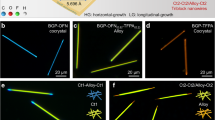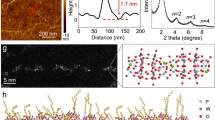Abstract
Controlling inorganic structure and dimensionality through structure-directing agents is a versatile approach for new materials synthesis that has been used extensively for metal–organic frameworks and coordination polymers. However, the lack of ‘solid’ inorganic cores requires charge transport through single-atom chains and/or organic groups, limiting their electronic properties. Here, we report that strongly interacting diamondoid structure-directing agents guide the growth of hybrid metal–organic chalcogenide nanowires with solid inorganic cores having three-atom cross-sections, representing the smallest possible nanowires. The strong van der Waals attraction between diamondoids overcomes steric repulsion leading to a cis configuration at the active growth front, enabling face-on addition of precursors for nanowire elongation. These nanowires have band-like electronic properties, low effective carrier masses and three orders-of-magnitude conductivity modulation by hole doping. This discovery highlights a previously unexplored regime of structure-directing agents compared with traditional surfactant, block copolymer or metal–organic framework linkers.
This is a preview of subscription content, access via your institution
Access options
Subscribe to this journal
Receive 12 print issues and online access
$259.00 per year
only $21.58 per issue
Buy this article
- Purchase on Springer Link
- Instant access to full article PDF
Prices may be subject to local taxes which are calculated during checkout






Similar content being viewed by others
References
Zhang, Y. et al. Direct observation of the transition from indirect to direct bandgap in atomically thin epitaxial MoSe2 . Nat. Nanotech. 9, 111–115 (2014).
Ugeda, M. M. et al. Giant bandgap renormalization and excitonic effects in a monolayer transition metal dichalcogenide semiconductor. Nat. Mater. 13, 1091–1095 (2014).
Lee, J. J. et al. Interfacial mode coupling as the origin of the enhancement of Tc in FeSe films on SrTiO3 . Nature 515, 245–248 (2014).
Kappera, R. et al. Phase-engineered low-resistance contacts for ultrathin MoS2 transistors. Nat. Mater. 13, 1128–1134 (2014).
Yaghi, O. M. et al. Reticular synthesis and the design of new materials. Nature 423, 705–714 (2003).
Leong, W. L. & Vittal, J. J. One-dimensional coordination polymers: complexity and diversity in structures, properties, and applications. Chem. Rev. 111, 688–764 (2011).
Simancas, R. et al. Modular organic structure-directing agents for the synthesis of zeolites. Science 330, 1219–1222 (2010).
Chakrabarty, R., Mukherjee, P. S. & Stang, P. J. Supramolecular coordination: self-assembly of finite two- and three-dimensional ensembles. Chem. Rev. 111, 6810–6918 (2011).
Furukawa, H. et al. The chemistry and applications of metal–organic frameworks. Science 341, 1230444 (2013).
Su, W. et al. Tunable polymerization of silver complexes with organosulfur ligand: counterions effect, solvent- and temperature-dependence in the formation of silver(I)-thiolate(and/or thione) complexes. Inorg. Chim. Acta 331, 8–15 (2002).
Fan, H. Nanocrystal-micelle: synthesis, self-assembly and application. Chem. Commun. 1383–1394 (2008).
Cui, H., Webber, M. J. & Stupp, S. I. Self-assembly of peptide amphiphiles: from molecules to nanostructures to biomaterials. Biopolymers 94, 1–18 (2010).
Zhao, D. Triblock copolymer syntheses of mesoporous silica with periodic 50 to 300 Ångstrom pores. Science 279, 548–552 (1998).
Dahl, J. E., Liu, S. G. & Carlson, R. M. K. Isolation and structure of higher diamondoids, nanometer-sized diamond molecules. Science 299, 96–99 (2003).
Schwertfeger, H., Fokin, A. A. & Schreiner, P. R. Diamonds are a chemist’s best friend: diamondoid chemistry beyond adamantane. Angew. Chem. Int. Ed. 47, 1022–1036 (2008).
Gunawan, M. A. et al. Diamondoids: functionalization and subsequent applications of perfectly defined molecular cage hydrocarbons. New J. Chem. 38, 28–41 (2014).
Schreiner, P. R. et al. Overcoming lability of extremely long alkane carbon–carbon bonds through dispersion forces. Nature 477, 308–311 (2011).
Fokin, A. A. et al. Stable alkanes containing very long carbon–carbon bonds. J. Am. Chem. Soc. 134, 13641–13650 (2012).
Wagner, J. P. & Schreiner, P. R. London dispersion in molecular chemistry-reconsidering steric effects. Angew. Chem. Int. Ed. 54, 12274–12296 (2015).
Nowacki, W. Die Krystallstruktur von Adamantan (symm. Tri-cyclo-decan). Helv. Chim. Acta 28, 1233–1242 (1945).
Makowski, M., Czaplewski, C., Liwo, A. & Scheraga, H. A. Potential of mean force of association of large hydrophobic particles: toward the nanoscale limit. J. Phys. Chem. B 114, 993–1003 (2010).
Wang, N., Tang, Z. K., Li, G. D. & Chen, J. S. Single-walled 4 Å carbon nanotube arrays. Nature 408, 50–51 (2000).
Perdew, J. P., Burke, K. & Ernzerhof, M. Generalized gradient approximation made simple. Phys. Rev. Lett. 77, 3865–3868 (1996).
Delley, B. An all-electron numerical method for solving the local density functional for polyatomic molecules. J. Chem. Phys. 92, 508–517 (1990).
Tkatchenko, A. & Scheffler, M. Accurate molecular van der Waals interactions from ground-state electron density and free-atom reference data. Phys. Rev. Lett. 102, 73005 (2009).
Lozano, E., Nieuwenhuyzen, M. & James, S. L. Ring-opening polymerisation of silver–diphosphine [M2L3] coordination cages to give [M2L3] coordination polymers. Chem. Eur. J. 7, 2644–2651 (2001).
Jiang, J.-J. et al. Structural disorder and transformation in crystal growth: direct observation of ring-opening isomerization in a metal–organic solid solution. IUCrJ 1, 318–327 (2014).
Espinet, P., Lequerica, M. C. & Martín-Alvarez, J. M. Synthesis, structural characterization and mesogenic behavior of copper(I) n-alkylthiolates. Chem. Eur. J. 5, 1982–1986 (1999).
Low, K.-H., Roy, V. A. L., Chui, S. S.-Y., Chan, S. L.-F. & Che, C.-M. Highly conducting two-dimensional copper(I) 4-hydroxythiophenolate network. Chem. Commun. 46, 7328–7330 (2010).
Talin, A. A. et al. Tunable electrical conductivity in metal–organic framework thin-film devices. Science 343, 66–69 (2014).
Yu, S., Xiong, H. D., Eshun, K., Yuan, H. & Li, Q. Phase transition, effective mass and carrier mobility of MoS2 monolayer under tensile strain. Appl. Surf. Sci. 325, 27–32 (2015).
Krukau, A. V., Vydrov, O. A., Izmaylov, A. F. & Scuseria, G. E. Influence of the exchange screening parameter on the performance of screened hybrid functionals. J. Chem. Phys. 125, 224106 (2006).
Raty, J.-Y., Galli, G., Bostedt, C., Van Buuren, T. W. & Terminello, L. J. Quantum confinement and fullerenelike surface reconstructions in nanodiamonds. Phys. Rev. Lett. 90, 37401 (2003).
Richter, R. et al. Size and shape dependent photoluminescence and excited state decay rates of diamondoids. Phys. Chem. Chem. Phys. 16, 3070–3076 (2014).
Sheberla, D. et al. High electrical conductivity in Ni3(2,3,6,7,10,11-hexaiminotriphenylene)2, a semiconducting metal–organic graphene analogue. J. Am. Chem. Soc. 136, 8859–8862 (2014).
Huang, X. et al. A two-dimensional π–d conjugated coordination polymer with extremely high electrical conductivity and ambipolar transport behaviour. Nat. Commun. 6, 7408 (2015).
Gimeno, M. C. & Gimeno, M. C. Handbook of Chalcogen Chemistry 33–80 (Royal Society of Chemistry, 2006).
Agarwal, R., Barrelet, C. J. & Lieber, C. M. Lasing in single cadmium sulfide nanowire optical cavities. Nano Lett. 5, 917–920 (2005).
Lu, M.-Y. et al. ZnO − ZnS heterojunction and ZnS nanowire arrays for electricity generation. ACS Nano 3, 357–362 (2009).
Voit, J. One-dimensional Fermi liquids. Rep. Prog. Phys. 58, 977–1116 (1995).
Yang, W. L. et al. Monochromatic electron photoemission from diamondoid monolayers. Science 316, 1460–1462 (2007).
Clay, W. A. et al. Origin of the monochromatic photoemission peak in diamondoid monolayers. Nano Lett. 9, 57–61 (2009).
Tkachenko, B. A. et al. Functionalized nanodiamonds part 3: thiolation of tertiary/bridgehead alcohols. Org. Lett. 8, 1767–1770 (2006).
Hohman, J. N. et al. Dynamic double lattice of 1-adamantaneselenolate self-assembled monolayerse on Au{111}. J. Am. Chem. Soc. 133, 19422–19431 (2011).
Skrabalak, S. E., Wiley, B. J., Kim, M., Formo, E. V. & Xia, Y. On the polyol synthesis of silver nanostructures: glycolaldehyde as a reducing agent. Nano Lett. 8, 2077–2081 (2008).
Stange, A. F., Klein, A., Klinkhammer, K.-W. & Kaim, W. Aggregation control of copper(I) thiolates through substituent size and ancillary chelate ligands: closely related mono-, di-, tri- and tetranuclear complexes. Inorg. Chim. Acta 324, 336–341 (2001).
Eichhöfer, A. et al. Homoleptic 1-D iron selenolate complexes—synthesis, structure, magnetic and thermal behaviour of ∞1[Fe(SeR)2] (R = Ph, Mes). Dalt. Trans. 40, 7022–7032 (2011).
MacDiarmid, A. G. et al. The concept of ‘doping’ of conducting polymers: the role of reduction potentials [and discussion]. Phil. Trans. R. Soc. A Math. Phys. Eng. Sci. 314, 3–15 (1985).
Bruker, SAINT and SADABS (Bruker AXS, 2007).
Kabsch, W. XDS. Acta Crystallogr. D 66, 125–132 (2010).
Sheldrick, G. M. Crystal structure refinement with SHELXL. Acta Crystallogr. C 71, 3–8 (2015).
Sheldrick, G. M. A short history of SHELX. Acta Crystallogr. A 64, 112–122 (2008).
Dolomanov, O. V., Bourhis, L. J., Gildea, R. J., Howard, J. A. K. & Puschmann, H. OLEX2: a complete structure solution, refinement and analysis program. J. Appl. Crystallogr. 42, 339–341 (2009).
McPhillips, T. M. et al. Blu-Ice and the Distributed Control System: software for data acquisition and instrument control at macromolecular crystallography beamlines. J. Synchrotron Radiat. 9, 401–406 (2002).
Grimme, S. Accurate description of van der Waals complexes by density functional theory including empirical corrections. J. Comput. Chem. 25, 1463–1473 (2004).
Zhao, Y. & Truhlar, D. G. The M06 suite of density functionals for main group thermochemistry, thermochemical kinetics, noncovalent interactions, excited states, and transition elements: two new functionals and systematic testing of four M06-class functionals and 12 other functionals. Theor. Chem. Acc. 120, 215–241 (2008).
Giannozzi, P. et al. QUANTUM ESPRESSO: a modular and open-source software project for quantum simulations of materials. J. Phys. Condens. Matter 21, 395502 (2009).
Okubo, T. et al. Crystal structure and carrier transport properties of a new semiconducting 2D coordination polymer with a 3,5-dimethylpiperidine dithiocarbamate ligand. Chem. Commun. 49, 4316–4318 (2013).
Acknowledgements
The authors thank M. Soltis and I. Mathews at SLAC National Accelerator Laboratory and S. Teat at Lawrence Berkeley National Laboratory for assistance with SC-XRD, and Y. Liang at Lawrence Berkeley National Laboratory for help with DFT computations. Part of this work was performed at the Stanford Nano Shared Facilities (SNSF). This work was supported by the Department of Energy, Office of Basic Energy Sciences, Division of Materials Science and Engineering, under contract DE-AC02-76SF00515. The work done at the Justus-Liebig University was further supported by the Deutsche Forschungsgemeinschaft, Priority Program ‘Dispersion’ (SPP 1807, Schr 597/27-1). Portions of this research were carried out at the Stanford Synchrotron Radiation Lightsource (SSRL), a Directorate of SLAC National Accelerator Laboratory and an Office of Science User Facility operated for the US Department of Energy Office of Science by Stanford University. The SSRL Structural Molecular Biology Program is supported by the DOE Office of Biological and Environmental Research, and by the National Institutes of Health, National Institute of General Medical Sciences (including P41GM103393). The contents of this publication are solely the responsibility of the authors and do not necessarily represent the official views of NIGMS or NIH. This research used resources of the National Energy Research Scientific Computing Center (NERSC) and Advanced Light Source (ALS), both of which are DOE Office of Science User Facilities supported by the Office of Science of the US Department of Energy under Contract No. DE-AC02-05CH11231.
Author information
Authors and Affiliations
Contributions
H.Y., J.N.H., Z.-X.S., P.R.S. and N.A.M. conceived the idea. H.Y., J.N.H., F.H.L., B.W. and T.R.K. performed the growth experiments and the physical measurements. H.Y., F.H.L., C.J. and T.P.D. performed the DFT computations. D.S.-I. and A.V. solved the crystal structures from SC-XRD data. J.E.P.D., R.M.K.C., B.A.T., A.A.F. and P.R.S. provided the diamondoids and synthesized their derivatives. H.Y., J.N.H. and N.A.M. wrote the paper. All authors contributed to the discussion and revision of the paper.
Corresponding author
Ethics declarations
Competing interests
The authors declare no competing financial interests.
Supplementary information
Supplementary Information
Supplementary Information (PDF 989 kb)
Supplementary Information
Crystallographic data for 1ADCu (CIF 258 kb)
Supplementary Information
Crystallographic data for 4DICu (CIF 273 kb)
Rights and permissions
About this article
Cite this article
Yan, H., Hohman, J., Li, F. et al. Hybrid metal–organic chalcogenide nanowires with electrically conductive inorganic core through diamondoid-directed assembly. Nature Mater 16, 349–355 (2017). https://doi.org/10.1038/nmat4823
Received:
Accepted:
Published:
Issue Date:
DOI: https://doi.org/10.1038/nmat4823
This article is cited by
-
Microwave-assisted synthesis of metal-organic chalcogenolate assemblies as electrocatalysts for syngas production
Communications Chemistry (2023)
-
Construction of conducting bimetallic organic metal chalcogenides via selective metal metathesis and oxidation transformation
Nature Communications (2022)
-
Solvent-mediated assembly of atom-precise gold–silver nanoclusters to semiconducting one-dimensional materials
Nature Communications (2020)
-
Laser-sculptured ultrathin transition metal carbide layers for energy storage and energy harvesting applications
Nature Communications (2019)
-
Sterically controlled mechanochemistry under hydrostatic pressure
Nature (2018)



